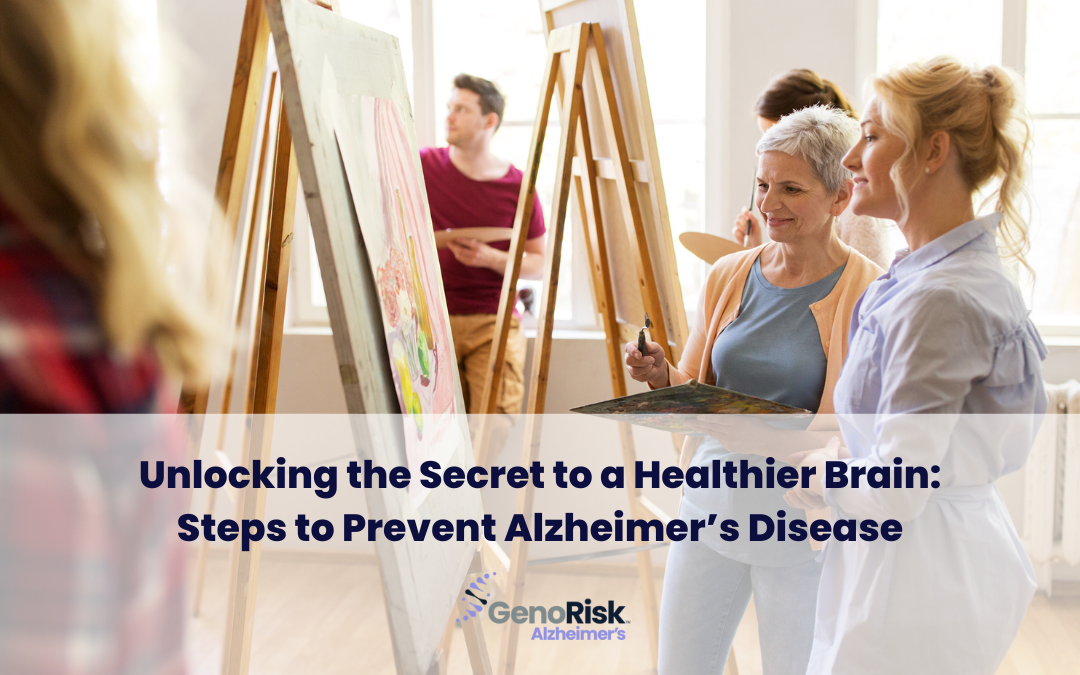What is Alzheimer’s Disease?
Alzheimer’s disease, the most common form of dementia, affects an estimated 6.7 million Americans over the age of 65, a number that is expected to grow to 8.8 million by 2050.
Dementia is an umbrella term that refers to changes in brain function that results in cognitive and functional decline. There are several different types of dementia including Alzheimer’s disease, vascular dementia, frontotemporal dementia, and Lewy body dementia.
Alzheimer’s disease is thought to be caused by the buildup of beta-amyloid and tau proteins, ultimately damaging neurons. Neurons are the nerve cells within the brain that are responsible for communication required for intellectual and physical functioning. As neurons are impaired, individuals may experience changes in memory, language, and thinking. As more neurons are affected, symptoms may also involve changes in behavior and difficulty with self-care.
While a small degree of age-related cognitive decline may be common, Alzheimer’s disease is different in that it affects memory and cognition in a progressively deteriorating manner. Alzheimer’s disease typically has several stages of progression:
Preclinical – Changes to the brain, including beta-amyloid and tau accumulation, start to develop, though no symptoms are detected. Interestingly, these brain changes can begin 20 or more years before symptoms develop.
Subjective Cognitive Impairment (SCI) – While not always recognized as an official stage, SCI occurs when an individual starts to notice changes in cognition but these changes are not yet apparent to others. SCI may, but does not guarantee, progression to MCI and Alzheimer’s disease.
Mild Cognitive Impairment (MCI) – Characterized by very mild changes in cognitive function, signs of MCI are typically apparent to the individual and those who are close to them, but others may not notice these more subtle changes.Mild, Moderate, and Severe Alzheimer’s disease – The individual has difficulty with more and more of their daily cognitive and physical functions, such as handling finances, completing daily tasks, and ultimately ability to communicate and take care of themselves.
Mild, Moderate, and Severe Alzheimer’s disease – The individual has difficulty with more and more of their daily cognitive and physical functions, such as handling finances, completing daily tasks, and ultimately ability to communicate and take care of themselves.
Risk Factors for Alzheimer’s Disease
The risk of developing Alzheimer’s disease is related to both non-modifiable and modifiable factors. Non-modifiable risk factors are those that can not be changed, while modifiable risk factors provide opportunities for intervention and potential prevention and/or slowing of disease progression.
Non-Modifiable Risk Factors –The non-modifiable risk factors for Alzheimer’s disease include an individual’s age, gender, family history, and genetics.
Age – The risk of Alzheimer’s disease increases with age. An estimated 5% of those 65 and older, 13% of those 75 and older, and 33% of those over the age of 85 are currently diagnosed with the disease.
Gender – Women tend to be at a higher risk of developing Alzheimer’s disease than men, with women currently making up two thirds of those who are diagnosed. The reason for this risk difference is unclear, however, and may be simply related to the fact that women generally tend to live longer than men, allowing more time for the disease to present and progress.
Family History – Having one or more close relatives with Alzheimer’s disease, such as a parent, sibling, or grandparent, increases one’s risk, and having more than one close relative further increases risk. It is important to note, however, that compared to age, genetics, and some of the modifiable risk factors, family history plays a smaller role in determining risk.
Genetics – Genes within each cell of the body are how different traits are passed on from parents to their children. Humans share 99.99% or more of the same genetic code, and it is the small differences that are the basis for differences in characteristics, including disease risk and risk of Alzheimer’s disease. Alzheimer’s disease is highly heritable, meaning that the risk of developing the disease has a genetic component.
Alzheimer’s Disease and Genetics – The APOE Gene
The gene with the greatest known effect on Alzheimer’s disease risk is called APOE. The APOE gene contains the code to make a protein called “apolipoprotein E,” which is responsible for moving fat throughout the body. Each person carries two copies of the APOE gene, one from each parent. The APOE gene comes in three forms: APOE-e2, APOE-e3, and APOE-e4, resulting in six possible individual combinations: e2/e2, e2/e3, e2/e4, e3/e3, e3/e4, and e4/e4.
The APOE-e2 form may decrease risk for Alzheimer’s disease. APOE-e3, the most common form of APOE, is associated with an average risk of Alzheimer’s disease. It is the APOE-e4 version of the gene that is associated with an increased risk of developing the disease. It is estimated that having one copy of the APOE-e4 gene increases risk 3-fold and having two copies increases risk 12-fold.
Despite APOE’s role in Alzheimer’s disease risk, it is important to note that one’s APOE status is not a diagnosis. Instead, the APOE gene speaks to a component of one’s risk, of which there are many other contributing factors. In fact, it is possible to have one or even two copies of the APOE-e4 gene and not develop Alzheimer’s disease. It is also possible to carry no copies of the APOE-e4 gene and still develop the disease. This is an important reminder that there are many factors that go into risk for developing Alzheimer’s disease.
Alzheimer’s Disease and Genetics – Additional Genes
While the APOE gene is thought to play the largest role in the genetic risk for Alzheimer’s disease, several other genes have been identified that are thought to contribute to risk as well. These genes, including CLU, CR1, PICALM, SORL1, and ABCA7, may be either protective or risk-promoting, making them important to one’s overall genetic risk.
GenoRisk™ Alzheimer’s Test
While most genetic tests evaluating for Alzheimer’s disease genetic risk have focused on the APOE gene alone, there is significant value to evaluating risk in terms of APOE gene status combined with other genes known to contribute to overall risk. The process of predicting disease risk based on the combination of several genes is known as a “polygenic” risk score, and may provide a more complete picture of the specific role genetics plays in overall health and risk of disease.
GenoRisk™ Alzheimer’s is a polygenic risk score that combines several genes known to influence the risk for Alzheimer’s disease, including APOE. In developing the GenoRisk test, it was found that there is a relatively wide range of risk within individuals with the same combination of APOE genes when other genetic factors are taken into account. In fact, individuals with two APOE-e3 genes, thought to have no increased risk in Alzheimer’s disease development, may in fact have a higher overall genetic risk than some patients with higher risk copies of the APOE gene, APOE-e4. This observation reinforces the importance of evaluating the larger group of genes known to affect Alzheimer’s disease risk, instead of APOE alone.
Genetics – Diagnosis versus Risk
As a reminder, assessing one’s genetic risk for developing Alzheimer’s disease, including APOE status and the GenoRisk polygenic risk score, is meant to be predictive of risk – not diagnostic. Several other factors, including those that are modifiable, also play a significant role in the development of the disease.
Rare Familial Alzheimer’s Disease
The more well-known form of Alzheimer’s disease discussed thus far is termed “common” or “sporadic” Alzheimer’s disease, which speaks to the prevalence as well as the fact that several risk factors contribute to disease development. This differs from the rare “familial” form of Alzheimer’s disease, which affects less than 1% of those diagnosed.
Familial Alzheimer’s disease is caused by changes in specific genes that result in a very high likelihood of developing an early-onset form of the disease, which is when symptoms appear before the age of 65.
The genes associated with familial Alzheimer’s disease are known as APP, PSEN1, and PSEN2. These genes are considered diagnostic, which means that having one or more high-risk versions is highly associated with ultimate disease development. This type of diagnostic genetic test is comparable to those used for other diseases, such as Huntington’s disease.
The GenoRisk Alzheimer’s test does not evaluate for the APP, PSEN1, or PSEN2 genes, nor does an APOE-only genetic test. These rare genes are most commonly evaluated with healthcare provider or genetic counselor oversight in situations when an individual has a strong family history of early-onset Alzheimer’s disease.
How Should GenoRisk Information be Used?
While taking a genetic test may cause some anxiety, being aware of one’s genetic risk for Alzheimer’s disease can be empowering and provide motivation to address the well-known modifiable risk factors for the disease. In recent years, the field of Alzheimer’s disease research has highlighted the importance of modifiable risk factors in reducing risk and progression of the disease. Hopefully, this is encouraging to individuals that may be concerned about genetic risk, family history, or early cognitive changes.
These modifiable risk factors include certain medical conditions as well as lifestyle habits including diet, exercise, sleep, stress levels, and social connections. There is good evidence that addressing and managing these factors in early life plays an important role in disease risk reduction.
Medical Conditions – Several medical conditions contribute to an increased risk of Alzheimer’s disease, including high blood pressure, diabetes, sleep apnea, and hearing loss. Appropriately managing these conditions may reduce the risk of Alzheimer’s disease. As changes in the brain that lead to Alzheimer’s disease begin to develop long before symptoms first appear, early identification and intervention of any risk-promoting medical conditions is important.
Diet – Diet and nutrient intake play an important role in health, including affecting risk of Alzheimer’s disease. The “MIND” diet, which is a version of the well-known Mediterranean and DASH diets, has been shown to reduce the risk of Alzheimer’s disease. The MIND diet encourages frequent intake of certain fruits and vegetables, lean proteins, and healthy fats and discourages regular intake of foods high in sugar and animal fats.
Exercise – Participating in regular physical activity is associated with improved overall health and well-being. In fact, both regular aerobic and strength training activities are important for maintaining cognitive health. Aerobic activities include walking, swimming, and bike riding, while strength training activities include using light weights, resistance bands, or even your own body weight to build muscle, strength, and balance. Remember to speak with your healthcare provider before beginning or changing your exercise routine.
Sleep – Sleep quantity and sleep quality both play a role in cognitive health throughout life. Most adults function best on 7 or more hours of sleep per night, though advancing age, medical conditions, and other lifestyle factors may make it difficult to get enough quality sleep. If you frequently struggle with sleep, first speak with your healthcare provider to identify any possible medical causes. You can then practice good sleep hygiene, which includes developing a calming and screen-free bedtime routine, going to bed and waking up at the same time each day, and limiting caffeine and alcohol intake.
Stress – While occasional feelings of stress are not likely harmful to health, chronic stress, anxiety, and depression may negatively affect cognition. After speaking with your healthcare provider about your concerns, there are many interventions that can help to manage stress levels, including deep breathing, meditation, and working with a trained therapist.
Social Connections – Having strong social connections and frequent social interactions is associated with improved health and longevity. There are many ways to become more socially active, including getting involved in local groups or organizations, volunteering, and making a point to have regular contact with family and friends.
The Future
Several exciting diagnostic and therapeutic options are emerging to help those at risk of or currently diagnosed with Alzheimer’s disease, and research in this space continues. While risk for Alzheimer’s disease clearly has a strong genetic component, we are also learning that several other aspects of risk are under our control. Take the first step in determining your genetic risk and taking action to reduce your risk by ordering a GenoRisk™ Alzheimer’s test today!







